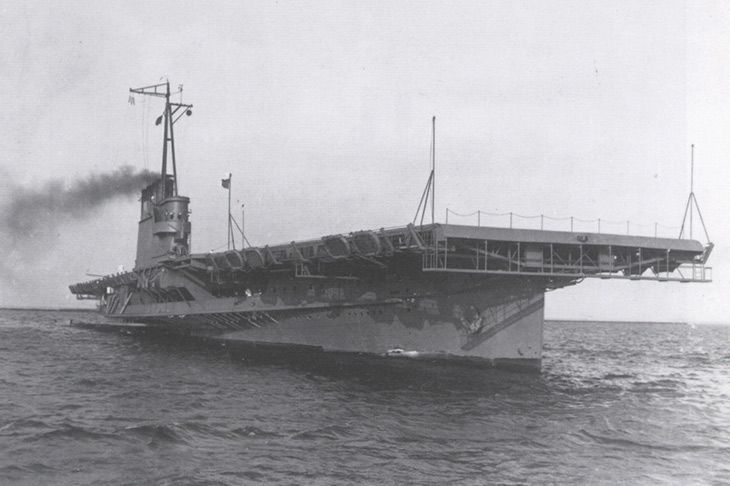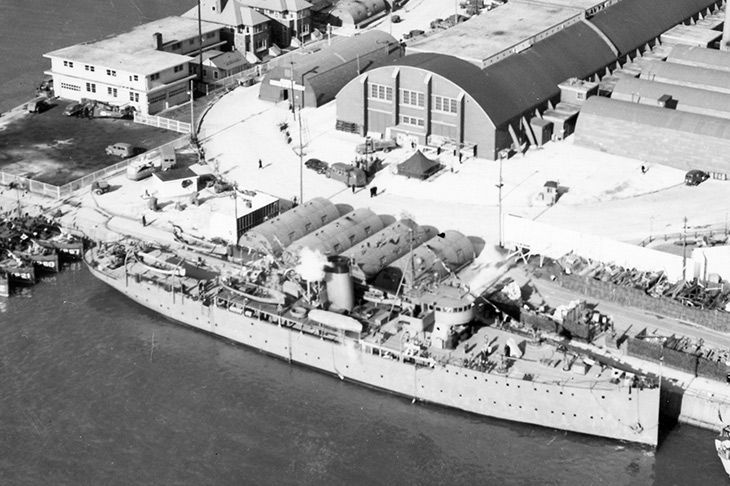Throughout both WWI and WWII, the U.S. Navy employed innovative solutions to provide training for new recruits. The vessels USS Wolverine, Sable, and Wilmette served the Sailors who would then go out to serve our nation.
During the early stages of WWII, Commander Richard F. Whitehead proposed the idea of retrofitting and modifying Great Lakes luxury cruise ships into aircraft carriers for naval training purposes. The radical and revolutionary concept called for training on Lake Michigan off of Navy Pier in Chicago, a safe and protected environment for sailors and their ships. After the attack on Pearl Harbor in 1941, the U.S. Navy accepted the proposal and put the plan into action.
USS Wolverine

USS Wolverine was commissioned August 12, 1942 in Buffalo, NY and began training operations shortly thereafter. USS Wolverine weighed in at 7,200 tons displacement, had a crew of 325, and could make 18 knots (about 20mph).
USS Wolverine served as a training aircraft carrier for the U.S. Navy, from 1942–1945. Along with her sister ship, USS Sable, she qualified over 18,000 pilots for carrier landings, significantly impacting the course of WWII.
USS Wolverine began life as a Great Lakes side-wheel paddle steamer, designed for luxury cruises. Originally named Seeandbee after the first initials of her owners, the Cleveland and Buffalo Transit Company, she provided an indulgent experience to her passengers. She launched on her maiden voyage on June 19, 1913. At the time, she was fitted with side-wheel paddles that offered improved maneuverability and additional stability, as well as a faster, quieter steam engine. However, by 1941, her excursion days had come to an end.
On March 12, 1942, the Seeandbee was acquired by the U.S. Navy. The ship would be soon be renamed USS Wolverine—after completing the work of converting her into an aircraft carrier.
To do so, the U.S. Navy had a 550 foot-long flight deck installed, designed exclusively for training purposes. The Navy’s combat aircraft carrier flight decks were closer to 800 feet, which made landing on USS Wolverine even more challenging. If a pilot could take off and land on the shorter flight deck, they could take off and land on any flight deck in the Navy's fleet.
On September 2, 1945, World War II officially came to an end. With the war ended, the need for freshwater training came to an end and USS Wolverine was decommissioned on November 7, 1945. USS Wolverine was then transferred to the War Shipping Administration, where she was later sold for scrap. She received both the American Campaign Medal and the World War II Victory Medal in recognition of her services, and for her contribution to America’s success in the war.
USS Sable

USS Sable was commissioned in 1942, joining the USS Wolverine in Lake Michigan. She logged her first landing and operated from Navy Pier in her training capacity for the remainder of the war.
USS Sable, like her sister ship USS Wolverine, was also a coal-fired, freshwater, side-wheel paddle-powered ship.
Sable also began life as a luxury steamer, providing lavish excursions and experiences. Originally called the Greater Buffalo, she was among the largest side-wheel paddle ships on the Great Lakes at the time. Her maiden voyage was May 13, 1925 and she boasted the latest in comfort and splendor, earning her the nickname “Majestic of the Great Lakes”. Though well-loved in her prime, during the Great Depression she was removed from service, instead docked as a “floating hotel” for a time, waiting to take back to the water.
In order to be used as a training vessel, the Greater Buffalo was stripped of her opulence, and a steel flight deck was installed. The deck would prove useful for more than simply landing; it became a testing ground for a selection of non-skid coatings over the course of its service. The flight deck was a mere 550 feet-long, approximately two-thirds the length of a combat aircraft carrier deck. But by the end of the war, USS Sable and USS Wolverine would boast over 135,000 landings, qualifying 18,000 pilots, including future president George H. W. Bush, for service in the Navy.
The end of the war marked the end of the need for both ships. USS Sable was decommissioned on November 7, 1945, sold to the Maritime Commission, and reported as “disposed of” in 1948. She received both the American Campaign Medal and the World War II Victory Medal in honor of her contribution and her service during the war.
USS Wilmette

USS Wilmette docked at the south seawall of Navy Pier in December 1944. Note the two 4-inch guns mounted on the foredeck, with a burst of steam coming from her single funnel. Here she is open to public tours during the Navy’s 6th War Loan Exhibition.
The SS Eastland would make history twice, once as a simple steam-powered passenger ship and once with new life as USS Wilmette as she helped to shape the course of World Wars I and II.
SS Eastland started out as a twin-screw steamer ship, built and launched from Port Huron, Michigan, completing her maiden voyage on July 16, 1903. She quickly gained a colorful history, first with a top-heavy design that made her prone to listing, and then with a mutiny in August of 1903. But her first real entry into history was one of unimaginable tragedy.
On July 24, 1915, the Eastland took on 2,573 passengers and crew members, venturing out on a joyful excursion. The Eastland, along with four other ships, were set to take employees and their families of the Western Electric Company’s Hawthorne Works from Cicero, Illinois to Michigan City, Indiana. For many of the workers, this was the first real holiday they had ever taken, and spirits were high as the ships began the journey. However, only minutes after the final passengers had boarded, the Eastland began to heavily list to port. While the crew did everything they could to stabilize her, water gushed in through the portholes below deck and within moments, the ship rolled completely over onto her port side, trapping hundreds of passengers inside.
Thousands of people poured in to help, but by the end, the casualty count reached 844 passengers and 4 crew members, a death toll exceeded only by the sinking of the Titanic.
Eastland was salvaged and subsequently sold to the Naval Reserve, where she would find her chance at redemption. She was refitted as a gunboat and renamed USS Wilmette on February 20, 1918, only three years after the disaster. She remained stationed at the Great Lakes Naval Station, serving as a training vessel for sailors during WWI. After the war, she continued to journey through the Great Lakes, transporting trainees to the Naval Station, and even sinking a captured World War I German U-boat on Lake Michigan. On February 17, 1941, she was given the hull designation of IX-29, and resumed Navy training in Chicago during WWII.
Together with the USS Wolverine and USS Sable, the USS Wilmette helped train thousands of sailors and especially deck gun crews for Merchant Marine ships, which were being fitted with armament to protect themselves against German submarines, which often attacked on the surface, marking her place in history for the second time. After the end of the war, she was decommissioned in November 1945, and later sold to the Hyman Michaels Company. The Eastland found a second life through the U.S. Navy and despite her initial tragedy, she went on to help the nation win a war.